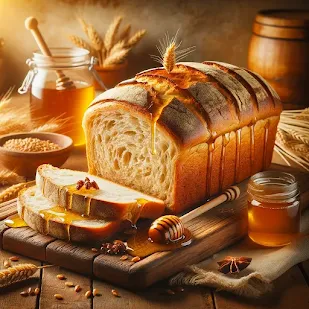Welcome to the heartwarming world of homemade bread with my Honey Wheat Bread. Crafted with care and kissed by the sweetness of honey, this wholesome loaf is a testament to the simple joys of baking. With a perfect blend of whole wheat and all-purpose flour, it offers a delightful balance of flavor and nutrition. Whether toasted for breakfast or used for sandwiches, every slice is a comforting reminder of the love and warmth that goes into homemade bread.
Origin Story: Homestead Honey Wheat Bread
Homestead Honey Wheat Bread is a wholesome, hearty bread that combines the nutty flavor of whole wheat with the natural sweetness of honey. This bread is perfect for sandwiches, toast, or simply enjoying with a pat of butter. Its origins and evolution reflect the simple, rustic traditions of home baking.
Historical Roots
The use of whole wheat flour in bread dates back to ancient civilizations. Whole wheat bread was a staple in the diets of the Egyptians, Greeks, and Romans, valued for its nutritional content. Unlike refined white flour, whole wheat flour retains the bran and germ, providing more fiber, vitamins, and minerals.
Honey, one of the oldest sweeteners known to humanity, has been used in baking for centuries. Ancient Egyptians used honey to sweeten their breads and cakes. The combination of honey and whole wheat flour in bread reflects a long-standing tradition of using natural ingredients to enhance flavor and nutrition.
The term "homestead" evokes images of early American settlers who baked their own bread using ingredients they had on hand. Honey wheat bread became popular in the United States during the back-to-the-land movement of the 1960s and 70s, when people began to seek out whole, natural foods and embrace traditional methods of food preparation.
Cultural Significance
Honey wheat bread holds a special place in the culture of home baking. It represents a return to simpler times, when families baked their own bread from scratch. The use of whole wheat flour and honey reflects a commitment to wholesome, natural ingredients. This bread is often associated with health and wellness, as it combines the nutritional benefits of whole grains with the natural sweetness of honey.
Personal Connection
My interest in Homestead Honey Wheat Bread began when I started exploring healthier alternatives to store-bought bread. The process of making bread from scratch, using simple and natural ingredients, was both rewarding and comforting. I was inspired by the rustic charm of homestead baking and the satisfaction of creating a nourishing food staple at home.
Recipe Evolution
Creating the perfect Homestead Honey Wheat Bread involves a few key steps. The use of whole wheat flour gives the bread its characteristic nutty flavor and dense texture. Combining whole wheat flour with all-purpose flour can help lighten the texture, making the bread less dense and more palatable.
Honey not only adds sweetness but also helps to retain moisture in the bread, keeping it fresh longer. The yeast should be proofed in warm water with a bit of honey to ensure it is active and will rise properly. Kneading the dough well helps develop the gluten, giving the bread structure and chewiness.
Ingredients:
Instructions:
- Activate Yeast: In a small bowl, combine warm water, honey, and active dry yeast. Let it sit for about 5-10 minutes until foamy.
- Mix Dough: In a large mixing bowl, combine whole wheat flour, all-purpose flour, and salt. Add the yeast mixture and olive oil. Stir until a dough forms.
- Knead: Turn the dough onto a floured surface and knead for about 5-7 minutes until smooth and elastic.
- First Rise: Place the dough in a greased bowl, cover with a clean kitchen towel, and let it rise in a warm place for about 1 hour or until doubled in size.
- Shape and Second Rise: Punch down the dough and shape it into a loaf. Place it in a greased loaf pan. Cover and let it rise for another 30-45 minutes.
- Preheat Oven: Preheat your oven to 350°F (175°C).
- Bake: Bake the bread for 30-35 minutes or until the top is golden brown and the bread sounds hollow when tapped on the bottom.
- Cool: Remove the bread from the pan and let it cool on a wire rack.
Pro Tips
- Fresh Honey: Use quality honey for a rich and delightful flavor.
- Storage: To keep your bread fresh, store it in a sealed plastic bag or airtight container.
Secret Tips
- Warm Environment: Ensure that the dough rises in a warm, draft-free environment. A slightly warm oven (turned off) or a cozy corner in your kitchen can be ideal for a successful rise.
- Double Proofing: For an even lighter and fluffier loaf, consider a double rise. After the first rise, punch down the dough, shape it, and let it rise again before baking.
- Bread Flour: If you prefer a slightly lighter texture, you can replace a portion of the whole wheat flour with bread flour.
- Honey Drizzle: For an extra touch of sweetness and shine, lightly drizzle honey over the top of the bread just before baking.
- Steam Oven: To achieve a crustier crust, place a shallow pan of hot water on the bottom rack of your oven while baking. The steam created will enhance the crust.
- Cool Completely: Allow the bread to cool completely on a wire rack before slicing. This helps retain the moisture and ensures a perfect texture.
It's the perfect addition to any meal and a delightful way to explore the world of homemade bread.









